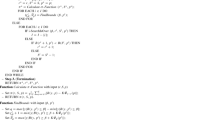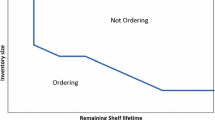Abstract
Food retail inventory management faces major challenges by uncertain demand, perishability, and high customer service level requirements. In this paper, we present a method to determine dynamic order quantities for perishable products with limited shelf-life, positive lead time, FIFO or LIFO issuing policy, and multiple service level constraints. In a numerical study, we illustrate the superiority of the proposed method over commonly suggested order-up-to-policies. We show that a constant-order policy might provide good results under stationary demand, short shelf-life, and LIFO inventory depletion.
Similar content being viewed by others

References
Bao J, Lee C, Lee LH (2007) The value of electronic marketplace in a perishable product inventory system with auto-correlated demand. OR Spectrum 29: 627–641
Brodheim E, Derman C, Prastacos GP (1975) On the evaluation of a class of inventory policies for perishable products such as blood. Manag Sci 22: 1320–1325
Broekmeulen RACM, van Donselaar KH (2009) A heuristic to manage perishable inventory with batch ordering, positive lead-times, and time-varying demand. Comput Oper Res 36: 3013–3018
Chen J, Lin DKJ, Thomas DJ (2003) On the single item fill rate for a finite horizon. Oper Res Lett 31: 119–123
Cohen MA (1976) Analysis of single critical number policies in perishable inventory theory. Oper Res 24: 726–741
Dawson J (2004) Food retailing, wholesaling and catering. In: Bourlakis MA, Weightman PWH (eds) Food supply chain management. Blackwell, Oxford, pp 116–135
Diks EB, de Kok AG, Lagodimos AG (1996) Multi echelon systems: a service measure perspective. Eur J Oper Res 95: 241–263
Fries B (1975) Optimal ordering policy for a perishable commodity with fixed lifetime. Oper Res 23(1): 46–61
Goyal SK, Giri BC (2001) Recent trends in modeling of deteriorating inventory. Eur J Oper Res 134(1): 1–16
Grocery Manufacturer Association (2008) 2008 Joint industry unsaleables report: the real causes and actionable solutions. http://www.gmabrands.com/publications/UnsaleablesFINAL091108.pdf
Gruen TW, Corsten D, Bharadwaj S (2002) Retail out of stocks: a worldwide examination of extent, causes and consumer responses. Grocery Manufacturers of America, Washington, D.C.
Ishii H (1993) Perishable inventory problem with two types of customers and different selling prices. J Oper Res Soc Jpn 36(4): 199–205
Kapalka BA, Katircioglu K, Puterman ML (1999) Retail inventory control with lost sales, service constraints, and fractional lead times. Prod Oper Manag 8(4): 393–408
Karaesmen I, Scheller-Wolf A, Deniz B (2008) Managing perishable and aging inventories: review and future research directions. In: Kempf K, Keskinocak P, Uzsoy R (eds) Handbook of production planning. Kluwer international series in operations research and management science. Kluwer, Dordrecht
Law AM, Kelton WD (2000) Simulation modeling and analysis, 3rd edn. McGraw-Hill, New York
Lütke Entrup M (2005) Advanced planning for fresh food industries—integrating shelf-life into production planning. Physica, Heidelberg
Nahmias S (1982) Perishable inventory theory: a review. Oper Res 30: 680–708
Nahmias S, Pierskalla W (1973) Optimal ordering policies for a product that perishes in two periods subject to stochastic demand. Nav Res Logist Q 20(2): 207–229
Nahmias S (1994) Demand estimation in lost sales inventory systems. Nav Res Logist 41(6): 739–757
Pierskalla WP, Roach C (1975) Optimal issuing policies for perishable inventory. Manag Sci 18(11): 603–614
Rafaat F (1991) Survey of literature on continuously deteriorating inventory models. J Oper Res Soc 42(1): 27–37
Smith SA, Agrawal N (2000) Management of multi-item inventory systems with demand substitution. Oper Res 48(1): 50–64
Silver EA, Pyke DF, Peterson R (1998) Inventory management and production planning and scheduling, 3rd edn. Wiley, New York
van der Vorst JGAJ, Beulens AJM, van Beek P (2000) Modelling and simulating multi-echelon food systems. Eur J Oper Res 122: 354–366
van Donselaar KH, de Kok AG, Rutten WGMM (1996) Two replenishment strategies for the lost sales inventory model: a comparison. Int J Prod Econ 46–47(1): 285–295
van Donselaar KH, van Woensel T, Broekmeulen R, Fransoo J (2006) Inventory control of perishables in supermarkets. Int J Prod Econ 104(2): 462–472
van Houtum GJ, Zijm WHM (2000) On the relationship between cost and service models for general inventory systems. Stat Neerl 54(2): 127–147
van Zyl G (1964) Inventory control for perishable commodities. Ph.D. thesis, University of North Carolina, Chapel Hill, NC
Williams CL, Patuwo BE (1999) A perishable inventory model with positive order lead times. Eur J Oper Res 116(2): 352–373
Williams CL, Patuwo BE (2004) Analysis of the effect of various unit costs on the optimal incoming quantity in a perishable inventory model. Eur J Oper Res 156(1): 140–147
Author information
Authors and Affiliations
Corresponding author
Rights and permissions
About this article
Cite this article
Minner, S., Transchel, S. Periodic review inventory-control for perishable products under service-level constraints. OR Spectrum 32, 979–996 (2010). https://doi.org/10.1007/s00291-010-0196-1
Published:
Issue Date:
DOI: https://doi.org/10.1007/s00291-010-0196-1



